1. Habit, David Levine
“What does it mean to spend more hours of a day as someone other than yourself?” David Levine asked in the catalogue text for Bauerntheater, his 2007 play in which an American actor planted a field full of potatoes in Germany. The same question resounded in this year’s production of Habit: a one-act American realist melodrama performed on eight hour loops by two rotating casts of method actors, who ate and bathed on set inside a fully-functional ranch house. Levine wasn’t really asking what it means to be someone else, so much as a providing a grating reminder that it’s what people do all day.
2. Harry Dodge, “Frowntown” at Wallspace
Harry Dodge’s “Frowntown” approaches a similar idea from a different standpoint. “Frowntown” included the outstanding video “Fred Can Never Be Called Bald,” which strings together found footage of gradual shifts, like approaching storms, dudes passing out, and dudes seriously injuring themselves, and intercuts them with lines from the continuum fallacy. It makes a state of being—like gender, as you’d gather from all of the drawings of dicks in the previous gallery, and Dodge’s own non-gendered identity—seem like a put-upon distinction. Some may be thrown off by the poor video quality, but the gradual blurring creates a sense of constant flux and turns slow violence into a force of nature. This, for me, comes close to a perfect work of art.
3. Nolan Hendrickson at Ramiken Crucible and Zach Feuer
Go Nolan. After generating a lot of buzz for his dynamo show of casually-painted, fresh, dinosauric figures in Greco-Roman motifs at Ramiken Crucible this spring, Hendrickson is now in a show at Zach Feuer alongside Eddie Martinez and JP Munro. His paintings work less as individuals than as one big groove, which is even more true of his new series Sportswear. Sexy gay 70s-style models tangle in a web of film equipment, spearing each other with light rays and boom mic poles, in a deadly orgy of narcissism.
4. Tom Sachs at the Armory
The Armory became a stoned thirteen-year-old’s playground this summer, where Tom Sachs installed his junkyard versions of a Mars landing rover, a quarantine facility, and a NASA monitor station. There, he directed a team of scientists and astronauts on eleven-hour Mars missions, surrounded by piles of empty McDonald’s and Starbucks. It was like a really great Wes Anderson movie.
Did the missions critique our culture’s drive for limitless colonial expansion, whatever the realities? Kinda. Could Sachs have achieved the same with half the resources and half the staff? Sure. But letting all that creativity run wild may have been worth it. The charm will run its course.
5. Jutta Koether at Bortolami
Jutta Koether’s rhythmic expressionism is not unlike that of Dana Schutz or Nolan Hendrickson, but I nominate this one over Schutz’s “Piano in the Rain” (which was just as good) because Koether’s was surprising. As a musician, Koether’s mark-making picks rhythm over traditional composition; here, the jagged zig-zags and decorative grape vines evoked an electric guitar mixed with fife. In scrawly, sketchy paintings, she combined Judeo-Christian motifs with Poussin’s “The Four Seasons”; the floor was covered in terracotta gravel, which added to the Mediterranean feel. Her jungle of art seems to reflect the way that history and culture have opened up for the plucking.
6. Santiago Sierra, “No, Global Tour”, Team Gallery
Santiago Sierra transported a five-foot-tall metal cutout of the word “NO” on trailers, ferries, and helicopters. The film “NO, Global Tour” documents the word, in black and white, rolling against highways, post-industrial towns, and billboards. In the background, late night hype radio begins to sound apocalyptic. It’s just as bleak as Sierra’s other works, but without the sadism.
7. Ghosts in the Machine, the New Museum
Ghosts in the Machine threw out the stuffy historical premise and just showed us a bunch of 20th century stuff that’s been influenced by machines. The show dug up work that we may never have been allowed to see otherwise, like drawings from psych wards or the surreal post-war bicycle ad “Silver Wheel” by the Japanese collective Jikin Koro. This was the perfect premise for bullshit hypotheses, but curators Massimiliano Gioni and Gary Carrion-Murayari left the theorizing to us.
8. Jack Goldstein at Venus Over Manhattan
Do we really need a revival show for a dead white guy who was already pretty famous in life? Actually, yes. Whatever you think of Jack Goldstein’s work, Adam Lindemann’s tribute show, celebrating his less popular paintings (complete with Patsy Cline soundtrack) reminded us that art is more than a peer group.
9. Nemesims, Muntean/Rosenblum, Team Gallery
Muntean/Rosenblum filled a scale model of a Sims house with new works and others by artists we’ve seen particularly lauded this year, like Gilbert and George, Lawrence Weiner, and Keith Haring. As self-defeating as art about the art market can be, this said more; the sleek digihouse felt completely natural in a gallery space with that Weiner and Haring.
10. Sam Gordon at Feature Inc
Sam Gordon’s paintings don’t look like much. He sewed together clothing and old blankets and covered them with mandala-like patterns made from studio sweepings, in a sort of art-as-life puzzle. Many of the shapes allude to cameras, with double perforations painted in rows on the sides, or a quilt that recalls a contracting camera lens. After studying them for several minutes, I noticed that he’s incorporated the thumbnail studies for each painting into the canvas itself, in the center or in a corner. I don’t know how much I took from this, other than that it’s exciting to decipher layers of a thing; that was enough.
Honorable mention
Michael Berryhill, Kansas
Berryhill seems to have made a breakthrough in his latest show of beautiful, amorphous still lives at Kansas. A few still suffer from generic subject matter, the same problem had by Berryhill’s earlier paintings of the studio, but the monumental painting “Schmevelations” in particular is getting somewhere. I look forward to his next show.
Liz Magic Laser at Derek Eller
I was obsessed with last year’s Performa play “I Feel Your Pain,” which was shown at Derek Eller this spring, along with “The Digital Face,” opposing videos of actors in body suits reenacting hand gestures from two State of the Union addresses. Both Barack Obama and George H. W. Bush look awfully imperial with the sound off.
Michael Mahalchick at CANADA
If I had a nickel for all the assemblage shows this year…well…there were a lot of them. But for Michael Mahalchick, stapling strips of bacon on the wall, tacking socks to flooded ceiling tiles, and putting a bong-like sculpture on a basketball carpet (“Basketball Wife”) seems like the ideal form of expression. (Wienerfest attendees will think now on the Judy Chicago dog). He tests the bounds of what people can deal with, in terms of just total fucking filth— often alluded to in paint or trash-like sculpture, but still a line not often crossed. Rather than looking like garbage and turning out to be a collector-friendly material, like a B Wurtz or a Vincent Fecteau, the objects kind of add up to an aura. When I was there, a twenty-year-old radio report on a earthquake was playing from an old couch in the center of the room, which made the whole thing feel like a broken-down time capsule. The work’s in dialogue with what’s come before—James Kalm has pointed out a semblance to Duchamp’s “The Bride Stripped Bare by Her Bachelors, Even.” I think Mahalchick’s our R. Mutt.

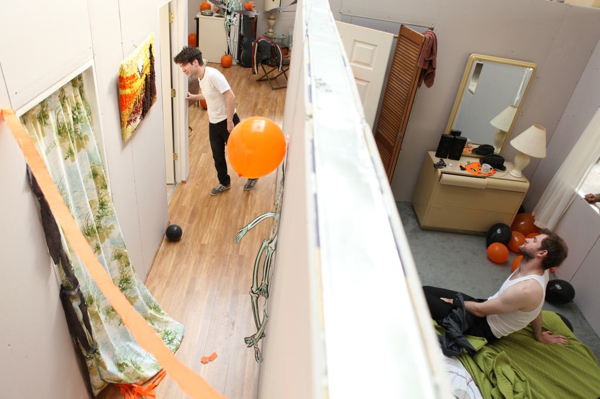
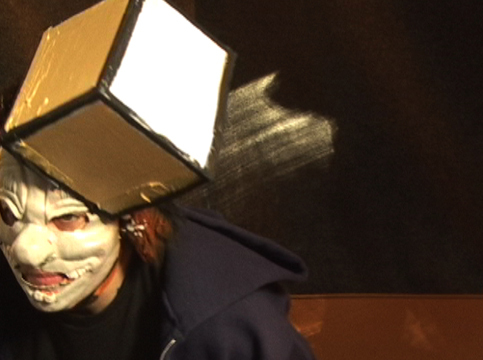

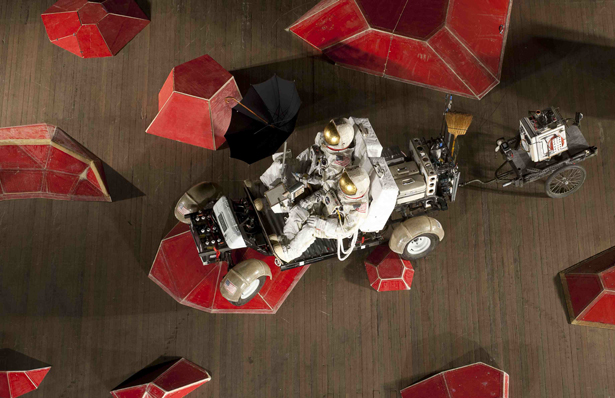



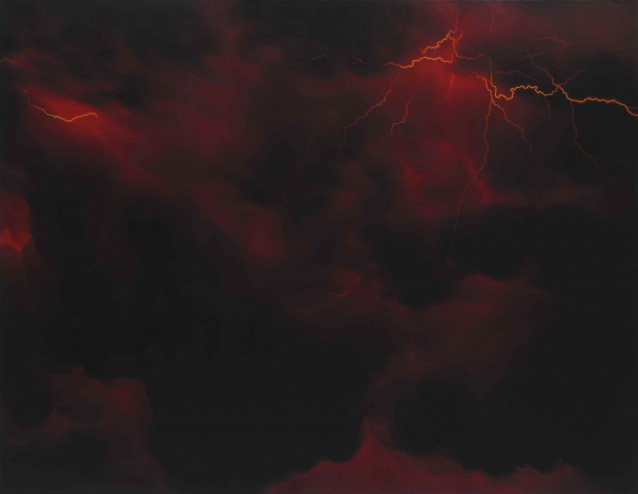
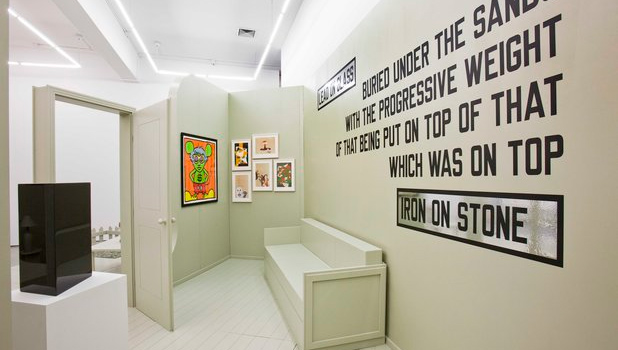
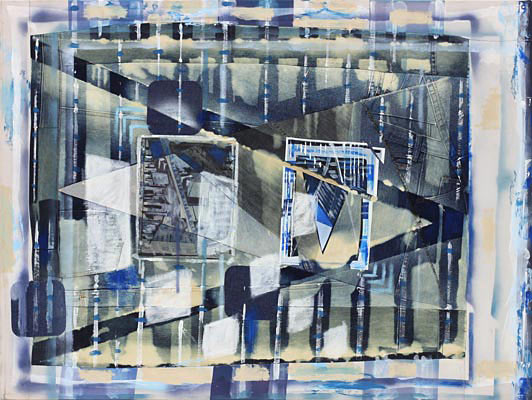

Comments on this entry are closed.